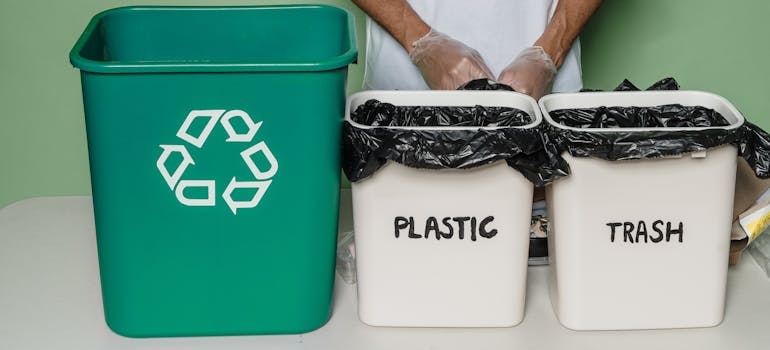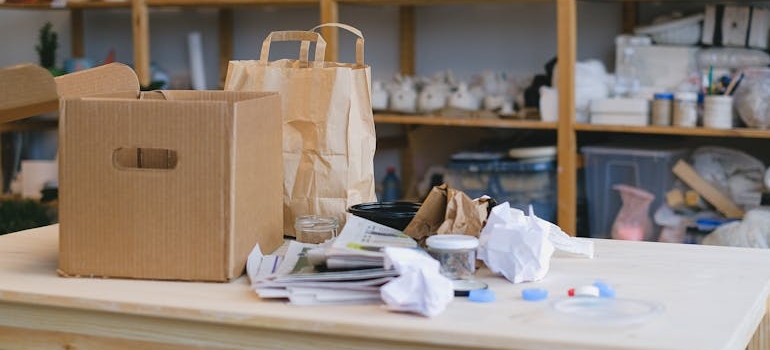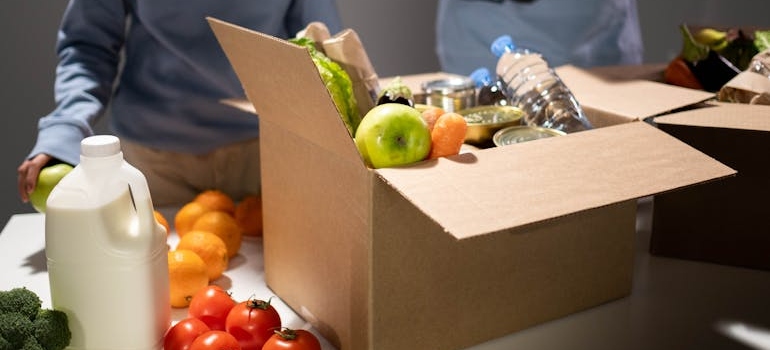10 Easy Steps to Make Your Move Eco-Friendly
Let’s face it—relocating isn’t exactly kind to our planet. From packing materials to transportation, the process of moving can have a significant environmental impact. But moving is an inevitable part of life for many Seattlites. While we can’t eliminate the environmental footprint entirely, we can take steps to reduce it significantly. This guide by the longstanding movers and packers in Seattle will walk you through ten easy steps to make your move eco-friendly, ensuring that your transition to a new home is as gentle on the Earth as possible.
Federal and State Emissions Standards
Federal and state vehicle emissions and fuel economy standards are mainly set by the Environmental Protection Agency (EPA) and the National Highway Traffic Safety Administration (NHTSA). In December 2021, the EPA issued its final rule to revise national greenhouse gas emissions standards for passenger cars and light trucks through model year 2026.
NHTSA issued its fuel economy standards for model year 2024–2026 light-duty vehicles in March 2022. Additionally, new standards limiting nitrogen oxide (NOx) emissions from heavy-duty trucks were released by the EPA in December 2022. Why does this matter?
These federal and state vehicle emissions and fuel economy standards are crucial because they ensure that moving companies use more fuel-efficient and lower-emission vehicles. Reducing the carbon footprint associated with the moving process directly supports the goal of making moving services in Seattle more eco-friendly. But do you know what you can do to help?

Step 1: Declutter Responsibly
One of the first and most impactful steps to make your move eco-friendly is decluttering responsibly. The more items you move, the larger your carbon footprint. When you reduce the number of belongings you transport, you cut down on moving costs but also lessen environmental impact. Instead of tossing out unwanted items, consider selling, donating, or recycling them:
- Sell: Use platforms like eBay, Craigslist, or local Facebook Marketplace groups.
- Donate: Organizations such as Goodwill, Salvation Army, or local shelters will gladly accept items in good condition.
- Recycle: Check local recycling programs for electronics, batteries, and other items not suited for the landfill.
Moreover, decluttering can also be financially beneficial. Selling unwanted items on platforms can help you earn extra money to offset moving costs. Donating items to organizations ensures that your usable items find a second life, benefiting those in need and keeping items out of landfills.
Step 2: Use Recycled Packing Materials
Using recycled and recyclable packing materials is a straightforward way to green your move. Traditional packing supplies, such as new cardboard boxes and plastic bubble wrap, contribute to deforestation and plastic pollution. Instead, opt for recycled boxes and biodegradable packing materials.
Many companies now offer recycled or partly recycled packing materials, and you can often find used boxes through community groups, friends who have recently moved, or local stores. Utilizing recycled materials reduces the demand for new resources and minimizes waste. According to data from the Sustainable Packaging Coalition, recycling one ton of cardboard saves over nine cubic yards of landfill space and conserves 46 gallons of oil.
In addition to recycled boxes, consider using biodegradable packing materials when moving with your chosen moving company in Washington. Products like cornstarch-based packing peanuts break down naturally and are a much better alternative to traditional styrofoam peanuts. Newspapers, old linens, and even clothing can serve as effective and eco-friendly protective layers for fragile items.

Step 3: Skip the Bubble Wrap
Bubble wrap is a popular packing material but far from eco-friendly. Fortunately, there are numerous sustainable alternatives that can protect your belongings just as well without environmental harm. Traditional bubble wrap is made from plastic, which is derived from petroleum—a non-renewable resource. Its production and disposal contribute significantly to pollution and landfill waste.
Instead of bubble wrap, consider using blankets, towels, and other household fabrics to wrap and protect larger items like TVs and mirrors. These materials are not only reusable but also provide excellent cushioning. For framed photos and artwork, placing them inside pillowcases and then within shipping crates offers snug and protective coverage. So, why don’t you safeguard your items but also make use of materials you already own, reducing the need for additional packing supplies?
Another effective alternative is to use paper plates between dishes to prevent chipping and breaking during transit. Reusable fabric wraps, such as those used in the traditional Japanese practice of Furoshiki, can cover smaller items and be used over and over again.
Step 4: Pack with Reusable Containers
Packing with reusable containers is an excellent way to reduce waste and make your move more eco-friendly. Traditional moving boxes are often used once and then discarded, contributing to landfill waste and deforestation. Instead, consider using reusable containers such as plastic bins, suitcases, duffel bags, and storage tubs.
Reusable containers have the advantage of durability and versatility. Plastic bins, for example, are sturdy and can be used multiple times, making them a more sustainable choice compared to single-use cardboard boxes. After your move, these containers can be repurposed for storage or future relocations.
According to the Foundation for Reusable Systems study, reusable plastic containers (RPCs) reduce greenhouse gas emissions by 60% compared to single-use packaging, which highlights the environmental benefits of using reusable containers over single-use options.

Step 5: Optimize Space Usage
Properly organizing and packing your belongings to make the most of available space is both practical and eco-friendly. Teaming up with HB move management and maximizing the use of space during your move can significantly reduce the number of trips required, thus cutting down on fuel consumption and emissions.
Start by utilizing the hidden storage spaces within your furniture. For instance, drawers, shelves, and even hollow areas under beds can be packed with smaller items. This technique not only saves space but also secures these items during transit. The Environmental Protection Agency (EPA) emphasizes that reducing the volume of items moved can decrease the overall environmental impact by lowering fuel usage and emissions.
In addition to furniture, use all available containers within your home. Suitcases, laundry baskets, and even tote bags can be filled with items, reducing the need for additional boxes. Nesting smaller items within larger ones, like placing smaller kitchen appliances inside pots and pans, further optimizes space usage and minimizes the number of trips needed for your movie.
Step 6: Choose Eco-Friendly Moving Companies
The transportation sector is the largest direct source of U.S. greenhouse gas emissions, accounting for 27.2 percent of the total. Cars and light-duty trucks, including pickups and SUVs, are responsible for 57.5 percent of these emissions.
Thus, selecting a moving company that prioritizes sustainability can significantly reduce your move’s environmental impact. Eco-friendly moving companies use practices and materials that minimize their carbon footprint and promote sustainability. So, when researching moving companies, look for those that:
- Use Fuel-Efficient Vehicles: Companies using hybrid or electric trucks can significantly reduce emissions.
- Offer Reusable Moving Supplies: Using reusable containers and packing materials minimizes waste.
- Employ Eco-Friendly Practices: Even if your heavy equipment movers are only optimizing routes to reduce fuel consumption, that practice can make a big difference!
Choosing an eco-friendly moving company helps the environment and supports businesses that are making efforts to reduce their ecological impact. This, in turn, encourages more companies to adopt sustainable practices, creating a positive ripple effect throughout the industry.
Step 7: Plan Your Route Wisely
Planning your moving route efficiently can significantly reduce the environmental impact of your relocation. Selecting the shortest and least congested routes minimizes fuel consumption and reduces greenhouse gas emissions. Utilizing GPS and route-planning apps helps identify the most efficient path. Additionally, avoiding peak traffic times enhances fuel efficiency and reduces travel time, making your move both eco-friendly and cost-effective.
A well-planned route not only saves on fuel but also reduces vehicle wear and tear, which can lower maintenance costs. For longer moves, consider combining trips and errands to maximize efficiency and minimize the number of journeys.

Step 8: Dispose of Hazardous Materials Properly
Proper disposal of hazardous materials is crucial for an eco-friendly move. Items such as paints, batteries, cleaning supplies, and electronic waste contain harmful chemicals that can contaminate the environment if not disposed of correctly. Many communities have designated drop-off locations or special collection events for hazardous materials.
Taking inventory of these items before your move allows you to find out the proper disposal methods in your area. Local government websites or waste management services often provide information on how and where to dispose of hazardous waste. Following their guidelines prevents environmental contamination and contributes to a safer, healthier planet.
Step 9: Partner with Move For Hunger
One innovative way to make your move eco-friendly and socially responsible is to partner with Move For Hunger. This non-profit organization collaborates with moving companies to reduce food waste and fight hunger by encouraging people to donate non-perishable food items when they move. Donations are then delivered to local food banks and pantries, helping to feed communities in need.
Food waste is a significant issue, with 38% of food produced in the U.S. going to waste each year, while millions of Americans face food insecurity daily. Move For Hunger offers a sustainable solution to this problem by utilizing the moving industry’s existing resources and logistics. How to get involved?
When you schedule your move with a participating moving company, they will provide you with a collection box for your non-perishable food items. Instead of throwing away perfectly good food that you no longer want to move, you can place it in the box. On a moving day, the movers will collect the food and deliver it to a local food bank or pantry. This simple act can make a significant impact, helping to reduce food waste and provide meals for those facing hunger.
Step 10: Set Up Your New Home with Sustainability in Mind
After successfully completing your eco-friendly move, the next step is to set up your new home sustainably. It involves incorporating practices and making choices that reduce your environmental footprint and promote a healthier living space.
Energy Efficiency
One of the most impactful changes you can make is to improve the energy efficiency of your new home. Start by switching to energy-efficient light bulbs, such as LEDs, which consume less power and have a longer lifespan compared to traditional incandescent bulbs. Additionally, consider installing a programmable thermostat to optimize your heating and cooling usage, which can significantly reduce energy consumption and lower utility bills.
Water Conservation
Implementing water-saving measures can also contribute to a more sustainable home. Install low-flow showerheads and faucets, and consider adding a dual-flush toilet system. These changes help reduce water usage without sacrificing performance. Collecting rainwater for irrigation and using drought-resistant plants in your garden can further conserve water resources.

Sustainable Materials
When furnishing and decorating your new home, opt for sustainable materials. Choose furniture made from reclaimed wood or recycled materials, and look for eco-friendly certifications such as FSC (Forest Stewardship Council) for wood products. Use non-toxic, low-VOC (volatile organic compounds) paints and finishes to improve indoor air quality and reduce harmful emissions.
Waste Reduction
Set up a comprehensive recycling system in your new home to manage waste effectively. Composting organic waste is another excellent way to reduce landfill contributions and create nutrient-rich soil for your Seattle garden. Additionally, minimize the use of single-use plastics by investing in reusable alternatives, such as cloth shopping bags, stainless steel water bottles, and glass storage containers.
Renewable Energy
If possible, consider incorporating renewable energy sources into your home. Installing solar panels can provide a significant portion of your energy needs and reduce reliance on fossil fuels. Many local governments offer incentives and rebates for renewable energy installations, making this an attractive and sustainable option.
Green Cleaning Products
Switch to eco-friendly cleaning products that are free from harsh chemicals and biodegradable. Many conventional cleaning products contain harmful substances that can negatively impact both the environment and your health. Eco-friendly alternatives are widely available and just as effective in maintaining a clean and healthy home.
Contribute to Lowering Carbon Emissions, Make a Positive Impact
Imagine the collective effect if everyone took these small steps during their move. Not only would it help in conserving resources, but it would also promote a healthier living environment for all. Even the smallest of efforts can inspire others to follow suit, creating a ripple effect of positive environmental action.
Now that you are familiar with ways to make your move eco-friendly, it’s time to put them into action. Start planning your green move today, and share your experiences with friends and family. Encourage them to adopt these practices and contribute to a more sustainable future. Together, local movers in Seattle and their clients can make a difference, one relocation at a time.
Why Choose Us
History
Hansen Bros. Moving & Storage is locally owned and operated by the same family for four generations, since 1890. We have a well-established reputation for service quality and reliability with a high percentage of repeat household and commercial clients.
Professionalism
We’re a certified ProMover by the American Moving and Storage Association with A+ rating with the Better Business Bureau, voted “Best in Western Washington” in 2009 and from 2011 to 2016 by KING5. Our company is fully licensed and insured and member of WMC and AMSA.
Value
Hansen Bros. Moving & Storage provide free, no-obligation in-home estimate and competitive rates, including low minimum rates for shipments moving under 300 miles. We’ve set a refund policy for unused packing materials and three Puget Sound locations to help clients save on travel fee costs.



